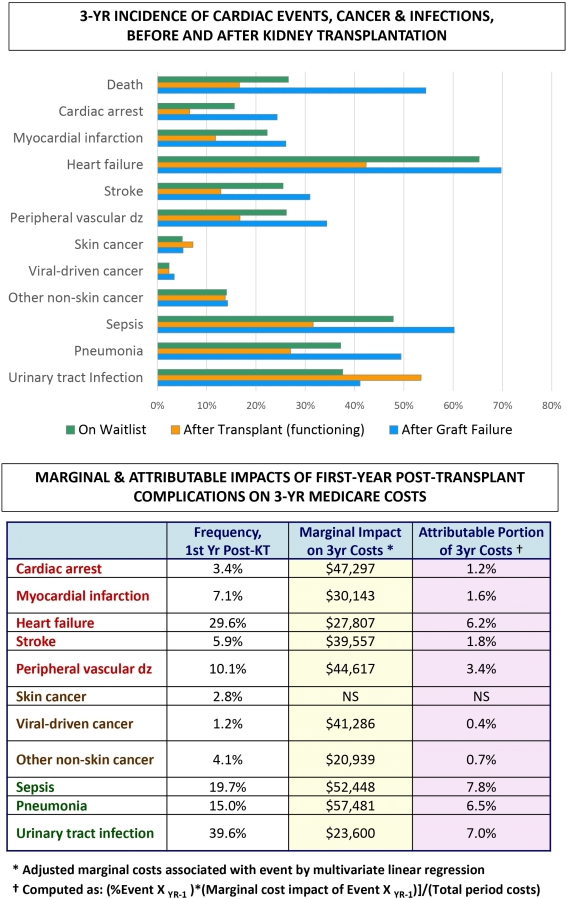The Economic Impact of Nonimmune Complications in Contemporary Kidney Transplantation
1Saint Louis Univ, St Louis
2Dartmouth, Lebanon
3Johns Hopkins, Baltimore
4Washington Univ, St. Louis.
Meeting: 2015 American Transplant Congress
Abstract number: 85
Keywords: Economics, Kidney transplantation, Medicare, Morbidity
Session Information
Session Name: Concurrent Session: Economics, Policy and Ethics
Session Type: Concurrent Session
Date: Sunday, May 3, 2015
Session Time: 4:00pm-5:30pm
 Presentation Time: 4:24pm-4:36pm
Presentation Time: 4:24pm-4:36pm
Location: Room 118-C
The clinical burden and economic impacts of nonimmune complications after kidney transplant (KT) are incompletely defined.
We examined United States Renal System Registry Data for Medicare-insured KT candidates (N=74,474) and recipients (N=70,316) in 2000-2011 to identify diagnoses of cardiac, malignant and infection events after listing, after KT, and after graft failure based on ICD9 diagnosis codes submitted with Medicare claims. 3yr cumulative event frequency in each phase of care was estimated by the Kaplan-Meier method. Among KT recipients, the marginal cost impacts of first-year complications on aggregated 3yr Medicare costs were quantified by multivariate linear regression including adjustment for recipient, donor, and transplant factors. We computed the proportions of total 3yr post-KT costs attributable to each first-year complication as: (%Event XYr1)*(Marginal cost impact of Event XYr1)/(Total period costs).
Compared to patients on the waitlist and after graft failure, KT recipients with functioning grafts had lower 3yr cumulative frequencies of cardiac events, sepsis, pneumonia and death, but higher frequencies of UTI and skin cancer (Figure). Viral-driven cancer was most common in those with failed grafts.
The average marginal impact of first-year post-KT complications (per event) on 3yr costs ranged from $20K for other cancers to $57K for pneumonia (Table). Weighted for frequency, the proportion of total costs attributable to the study complications ranged from <1% for non-skin cancer, 1% to 6% for cardiac events, and 6.5% to 8% for the studied infections (Table).

While the burden of nonimmune complications is generally lower in the first 3yrs with a functioning KT compared to experience on the waitlist or after graft failure, cardiac, malignant and infection events are important sources of morbidity and healthcare costs after KT. These complications reflect important targets for management protocols to improve post-KT outcomes and reduce costs of care.
To cite this abstract in AMA style:
Lentine K, Schnitzler M, Axelrod D, Segev D, Brennan D, Tuttle-Newhall J, Xiao H, Kucirka L, Dharnidharka V. The Economic Impact of Nonimmune Complications in Contemporary Kidney Transplantation [abstract]. Am J Transplant. 2015; 15 (suppl 3). https://atcmeetingabstracts.com/abstract/the-economic-impact-of-nonimmune-complications-in-contemporary-kidney-transplantation/. Accessed July 3, 2025.« Back to 2015 American Transplant Congress
